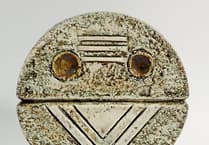COULD the notorious Abertillery child killer Harold Jones also be responsible for the unsolved 'Jack the Stripper' slayings that devastated London in the swinging sixties?
That is the question poised by local author Neil Milkins in his new book "Who Was Jack The Stripper," which reinvestigates the unsolved and brutally savage Hammersmith Nudes Murders which left a nation horrified and reeling in disbelief.
Jack the Stripper was the nickname given to an unknown serial killer responsible for the murder of six, possibly eight prostitutes in London between 1964 and 1965.
The killer's modus operandi was similar to Jack the Ripper.
This twisted predator would target lone and vulnerable prostitutes before strangling them to death. He would then strip them naked and knock their teeth out for souvenirs.
The sadist sent his last victim to the grave nearly 50 years ago, and despite a massive police hunt at the time, the killer known as Jack the Stripper was never found.
Since writing 'Every Mother's Nightmare,' which covers in great detail the double child murders that the then 15-year-old Harold Jones was originally convicted of in the 1920s, author Neil Milkins believes he has unearthed evidence which links Harold Jones to the Jack the Stripper killings.
Despite being labelled as a dangerous psychopath after brutally bludgeoning two Abertillery girls to death, Harold Jones, against the warnings of the prison psychiatrist and governor, was released in 1941.
Upon regaining his liberty, Harold Jones changed his name and became just another anonymous member of society.
However, Milkins has traced the movements of Harold Jones, who was then living under the assumed name of 'Harry Stevens' and 'Harry Jones' and discovered that Jones was living and working in the area when the poor girls were slaughtered.
Somewhat chillingly, Milkins also points out that the last of 'Jack the Stripper's' victims, Bridget O' Hara, was killed on January 11, 1965 - Harold Jones's 58th birthday.
Over the years the a number of men have been accused of the murders - the most sensational was probably boxer 'Fearless' Freddie Mills, crowned light-heavyweight champion of the world in 1948.
Mills, a darling of the media and a hero to millions, was found in July 1965, six months after the last of the murders slumped in the back of a car in Soho with a gunshot wound to his head. He later died in Middlesex Hospital.
His family and many of his closest friends, including the Kray twins, believed Mills had been murdered.
Bruce Forsyth and Henry Cooper were bearers at his funeral as was boxing promoter Jack Solomons.
The detective responsible for bringing the Kray twins to justice, Leonard 'Nipper' Read headed the police inquiry into the death of Mills and ruled his demise as suicide.
Similar to the Jack the Ripper slayings of the nineteenth century, Jack the Stripper's reign of terror ended in 1965 without the killer being caught.
In the same period a security guard called Mungo Ireland who lived in the area of the murders, gassed himself to death in a car. Ireland left a suicide note which read, "I cannot stand the strain any more."
Police viewed it as a possible confession on Ireland's behalf. Interestingly, he lived only two streets away from Harold Jones.
Mr Milkins explained, "It is not my intention to claim that Harold Jones was responsible for any or all of the murders in London.
However the facts are though, that Jones was not released from prison after he had killed two young girls because he was repentant.
"In fact, throughout his prison life he was found to be callous and was seen as a 'no-hoper.'
"The only reason he was released from prison was because of the Second World War, and because the prison authorities hoped that it would give Jones "his chance in life.
"After his release Jones would often walk around Abertillery on his 'home visits' as though he were a star and had something to be proud of.
"Records show that he was certainly proud of the fact that he had beaten Scotland Yard after he had attempted to rape and then kill eight-year-old Freda Burnell."
Milkins added, "All of the eight London murders were committed within a short distance of the Fulham and Hammersmith areas.
"Harold Jones, claiming to be Harry Stevens lived in Hestercombe Avenue, Fulham until 1962. He was then registered on the electoral roll as Harry Jones and living at Aldensley Road, Hammersmith."
Professor of Criminology David Wilson said, "I think Neil's book sheds new light on the Hammersmith murders.
"We know that Harold Jones was living in the area of the Jack the Stripper killings, and in my experience there is no such thing as coincidence when dealing with serial killers."
Milkins added, "Although none of the London victims were children, it should be noted that in 1948, Jones had progressed from an interest in young girls and had married a 35-year-old-woman.
"It sends shivers up my spine to think that this evil psychopath could have killed his last victim on his birthday as one last present to himself."
"If Jones was responsible for the murders and was able to confide in anyone, he would certainly have bragged in regard to the Scotland Yard detectives, "I beat them again."
"Who was Jack the Stripper" by Neil Milkins is currently available in all good bookshops.



